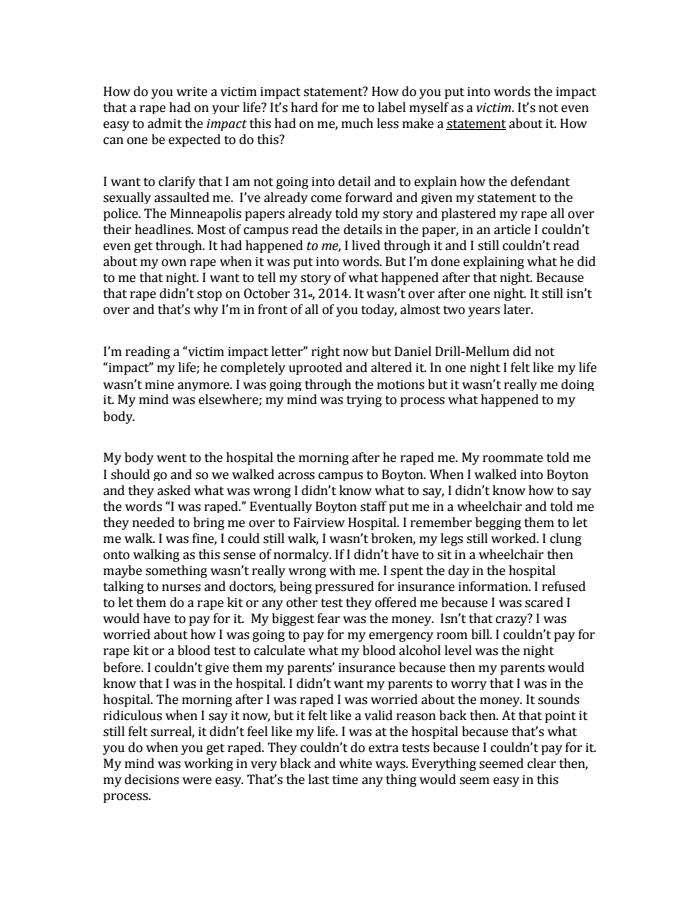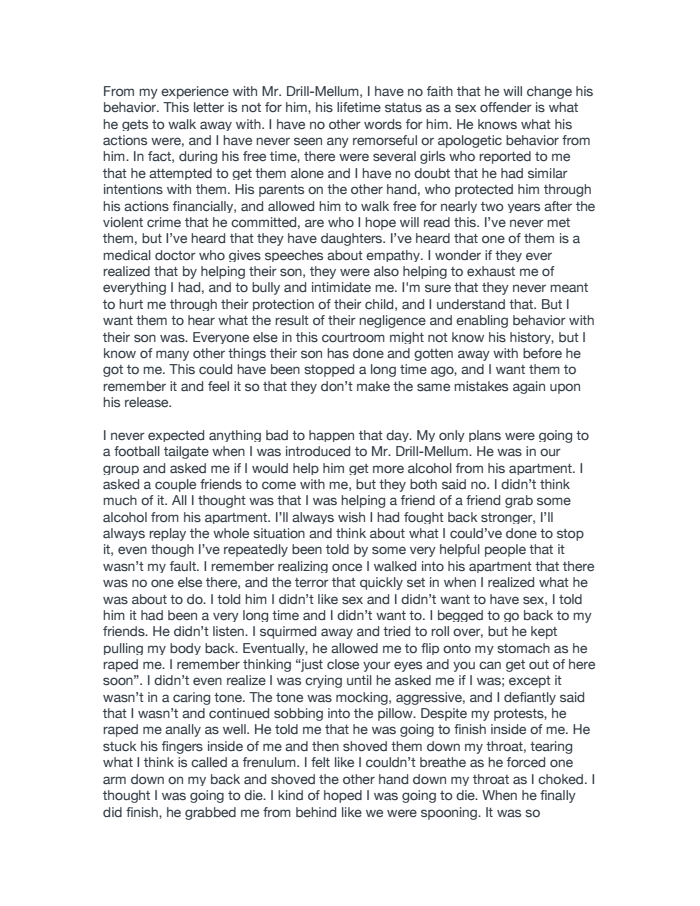With the recent wave of new rape allegations against Bill Cosby, and the controversy surrounding a Rolling Stone article alleging that a gang rape at a University of Virginia fraternity house went unpunished, sexual assault has been in the headlines more than usual.
Unfortunately, the reinvigorated conversation around the topic has included a lot of stubborn assumptions about rape and harmful stereotypes about victims.
These misconceptions perpetuate a culture in which sexual assault too often goes unreported and perpetrators go unpunished. Here are nine of the most common myths about sexual assault*, and why they’re simply not true.
Myth #1: You can’t trust rape allegations because they’re so often false
There’s some debate about this, but it’s generally estimated that between two and 10 percent of rape allegations are false, according to various studies and interpretations of FBI data — not a very high percentage, and certainly not high enough to support the widespread skepticism that tends to surround rape allegations. The exact percentage of false allegations is hard to pin down because there’s so much debate about how exactly to determine which reports are false.
But really, even if the number were much higher, it wouldn’t provide a good basis for the assumption that any individual victim was lying about her experience. After all, people have lied about having their cars stolen plenty of times, but this doesn’t lead us to question everyone who makes this claim.
The bottom line is that it makes sense to approach individual rape allegations based on their particular facts, not assumptions about what typically happens that could discourage rape victims from reporting the crime.
In one 2010 study, researchers at the University of Massachusetts, Boston, and Northeastern University found that out of 136 cases of sexual assault reported to university over a 10-year period, eight were coded as false.
/cdn0.vox-cdn.com/uploads/chorus_asset/file/2523972/sexual_assault_allegations.0.0.png)
In a 2010 study from Massachusetts researchers, eight out of 136 cases of sexual assault reported to a Northeastern university over a 10-year period were coded as false. (Jody Sieradzki / Dadaviz)
“The stereotype that false rape allegations are a common occurrence, a widely held misconception in broad swaths of society, including among police officers, has very direct and concrete consequences,” the authors wrote. “It contributes to the enormous problem of underreporting by victims of rape and sexual abuse.”
Myth #2: Sexual assault happens because of the way women dress
There’s a widely held belief that a good strategy for people — especially women — to avoid sexual assault is to wear clothes that will make them less sexually attractive to potential attackers. For example, conservative radio host Laura Ingraham has suggested that encouraging girls to forgo “immodest” clothing could help to avoid rape.
EXPERTS SAY SEXUAL ASSAULT STEMS FROM A PERSON’S DETERMINATION TO EXERCISE POWER OVER SOMEONE ELSE
But it’s absurd to think that style of dress would ever invite or excuse a crime (Is a man with an expensive watch asking to be robbed? No.)
Experts say sexual assault stems from a person’s determination to exercise power over someone else, not from being uncontrollably aroused by their victim’s appearance. Plus, most of the time, it’s planned in advance, a fact that pokes another hole in the theory that attackers simply see provocative clothing and are unable to control themselves.
Last March, women on Twitter challenged this myth by describing the clothes they were wearing when they were sexual assaulted — jeans, t-shirts, kids’ pajamas, sweats, school uniforms, etc. — to make a statement about the absurdity of blaming victims’ clothing for their attacks. The only meaningful risk factor is the presence and conduct of a rapist or sexual predator.
Myth #3: Sexual assault happens when someone is uncontrollably aroused
Underscoring the point above — that women can’t prevent rape with their style of dress — is this: sexual assault is an act of physical violence and domination, not a “crime of passion” that is motivated by sexual attraction. We know that rape is a crime of violence using sex, not a crime that is primarily motivated by sexual desire, and that most perpetrators of sexual assault have access to sex with someone other than their victim.
THIS IS PRETTY BASIC: ALMOST EVERYONE HAS SEXUAL DESIRES, AND NOT EVERYONE COMMITS SEXUAL ASSAULT
This is pretty basic: almost everyone has sexual desires, and not everyone commits sexual assault. Neither men nor women physically need to have sex after becoming sexually excited. We’re all very much able to control ourselves after becoming aroused, if we choose to do so. Belief in this myth can lead us to blame the victim and not hold the rapist accountable for his or her actions.
Myth #4: It’s not rape if you’ve dated or had consensual sex before
It’s not unusual at all for a victim and attacker to have had a previous relationship. Scrutiny of what the victim did before the alleged rapeplaces the responsibility of the offender’s actions with the victim and takes the focus off of whether she consented to the sexual activity that’s in question.
So whether a victim went to her attacker’s home or dorm room, or whether she previously consented to or engaged in some sexual activity, does not tell us anything about what happened in the moment she said she was assaulted. Consent to sex is something that can be given at one time, and withheld at another. No matter what the relationship, or what happened before, sexual activity forced upon another without consent is sexual assault.
Myth #5: Real sexual assault victims go to the police right away
This belief is dangerous because it creates skepticism about claims of victims if they’re not voiced immediately after the alleged assaults. But it’s not true that most victims contact law enforcement, and it’s even less true that they do so immediately after being attacked.
According to the Department of Justice, it’s estimated that a full 60 percent of sexual assaults go unreported. There are plenty of good reasons a sexual assault victim might hesitate to go to the police: the stress of talking to a stranger about a traumatic experience, doubt that the accuser will be held accountable, anxiety about participating in a trial and having to face an attacker, not knowing that the incident qualified as sexual assault, misplaced shame — and of course, concerns about not being believed. A person’s choice not to report an assault, or not to report it immediately, can mean a lot of things. What it definitely doesn’t mean is that the assault didn’t happen.
Myth #6: Rape is easy to avoid if you stay away from dangerous places and suspicious strangers
There’s a myth that most sexual assaults occur at the hands of deranged men who attack women they don’t know. This idea is perpetuated because stranger assault is more widely reported in the media and to the police than assault that occurs between people who know each other. But rape and sexual assault can occur at any time, any place, to anyone, and by anyone.
RAPE AND SEXUAL ASSAULT CAN OCCUR AT ANY TIME, ANY PLACE, TO ANYONE, AND BY ANYONE.
According to a report based on FBI data, almost 70 percent of sexual assaults reported to law enforcement occurred in the home of the victim, the offender, or another person. Sexual assault can be committed within any type of relationship, including in marriage, in dating relationships, or by friends, acquaintances or co-workers. Sexual assault can occur in heterosexual or same-gender relationships. It does not matter whether there is a current or past relationship between the victim and offender; unwanted sexual activity is still sexual assault and is a serious crime. So the idea that avoiding sexual assault is matter of avoiding strangers who jump out from behind bushes in high-crime areas simply doesn’t hold up.
Myth #7: If a person doesn’t fight back physically, she wasn’t really raped
The FBI recently broadened its definition of rape to ditch the word “forcible,” reflecting the modern understanding that sexual assault doesn’t always involve a victim who was physically overpowered by her attacker. Unfortunately, some people still believe that women who really don’t want to be raped use all of their strength and self-defense skills to stop their attackers.
CNN’s Don Lemon seemed to endorse this view recently when he said to Joan Tarshis, a woman who said she was raped by Bill Cosby in 1969, “You know, there are ways not to perform oral sex if you don’t want to do it,” suggesting that she should have used her teeth as a weapon. This “if you really didn’t want it, why didn’t you fight back harder?” position ignores that there are actually many ways that rape can occur, and many reasons it might be imprudent or impossible for a victim to attempt to physically overpower her attacker. An attacker might threaten his victim with a weapon or with other consequences if she doesn’t submit.
This type of submission — often done for survival — is not the same as consent. In fact, studies have shown that women who fight back aremore likely to be seriously injured by their attacker.
SUBMISSION — OFTEN DONE FOR SURVIVAL — IS NOT THE SAME AS CONSENT.
In addition, in cases like Tarshis’ account of what happened between her and Cosby (which he’s denied, along with the rest of the rape allegations against him), the victim might be under the influence of drugs or alcohol and physically unable to resist. Relatedly, there is no “right way” to react after a sexual assault. Sexual violenceexhibits a spectrum of responsesto the assault. They might be calm, withdrawn, hysterical, angry, apathetic, in denial, or in shock — just like victims of any other crime. In fact, their reactions may be even more complicated because of attitudes toward sexual assault that make them feel particularly traumatized or ashamed.
Myth #8: Only women can be victims of sexual violence.
In another myth that’s fueled by media portrayals, many people imagine that rape is only committed by straight men, against straight women. But sexual assault is not defined by the gender of the perpetrator or the person who is victimized. In fact, this is another clarification made by the FBI’s recently updated definition of rape, which now has no mention of gender.
It is true that in the majority of cases of reported rape, the victims are women. In fact women are 10 times more likely to be victims of sexual assault than men. Still, it is estimated that about one in thirty-three men have experienced attempted or completed rape in their lifetime.
It’s also possible for women to rape men. “Often, male survivors may be less likely to identify what happened to them as abuse or assault because of the general notion that men always want sex,” said Jennifer Marsh, the vice president for Victim Services at RAINN, an anti-sexual violence organization saId in an interview with CNN. Plus, “males have the added burden of facing a society that doesn’t believe rape can happen to them … at all,” said psychotherapist Elizabeth Donovan.
Meanwhile, some believe that rape only happens to men in prison. While this is a serious issue, it’s not the only place men are victimized. A related myth used to shame and silence male rape victims is that orgasm means coerced sexual activity was actually consensual. In fact,orgasm does not mean that someone “enjoyed” the sex, or that they wanted it. It can be a natural biological reaction that a male rape victim cannot control.
Myth #9: Sex with someone who’s too drunk or drugged to agree to it is okay
There are an incredible number of cultural references — from jokes about “roofies” to modern song lyrics about drugging women into sexual submission — that some might be confused and think it’s a normal practice for men to have sex with women who otherwise wouldn’t consent to sex, but have lowered inhibitions thanks to drugs or alcohol. Being under the influence of alcohol or drugs is not an invitation for non-consensual sexual activity.
Under many state laws, a person who is cognitively impaired due to the influence of drugs or alcohol is not able to consent to sexual activity. The act of an offender who deliberately uses alcohol as a means to subdue someone in order to engage in non-consensual sexual activity is also criminal.
A related myth is, “If you wouldn’t have been drinking, you wouldn’t have been sexually assaulted.” Consider this explanation from the University of Michigan’s Sexual Assault Awareness and Prevention Center: “Alcohol is a weapon that some perpetrators use to control their victim and render them helpless. As part of their plan, an assailant may encourage the victim to use alcohol, or identify an individual who is already drunk. Alcohol is not a cause of rape; it is only one of many tools that perpetrators use.”
ALCOHOL IS NOT A CAUSE OF RAPE; IT IS ONLY ONE OF MANY TOOLS THAT PERPETRATORS USE.
California’s new Yes Means Yes law— along with many college and university policies across the country — explicitly states that people who are under the influence of drugs and alcohol are incapable of providing the consent required for sex.
*Note: The exact definitions of “rape” and “sexual assault” differstate by state. This piece uses them interchangeably and discusses myths that apply to all unwanted sexual contact.
Title IX is best known for the effect it had on women’s athletics because it required that colleges provide equal opportunities in sports to men and women. After it took effect, female participation in college and high school sports more than quadrupled.
But Title IX is more than that: passed in 1972 as part of a broader education law, it prohibits any discrimination in education based on sex. Schools and colleges that receive federal funding can’t deny opportunities to students based on their gender.
The Obama administration has used the statute to examine how colleges handle accusations of sexual assault. The Education Department sent a letter in 2011 reminding colleges of their responsibility to deal with allegations of sexual harassment and assault that they either know about or should reasonably know about. Since then, the department has opened investigations into more than 50 colleges for alleged mishandling of sexual assault on campus.
Many of the allegations are at high-profile elite colleges:
- At Yale, just one student found responsible for “nonconsensual sex” in the first half of 2013 was suspended; the rest were given written reprimands or no punishment at all, the Huffington Post reported.
- At Brown, a student found responsible for sexual violence was suspended for a year, even though that meant he and his victim would be on campus at the same time after he returned.
- When a freshman at St. Mary’s College was sexually assaulted by a Notre Dame football player and reported the assault to Notre Dame campus police, the university didn’t begin an investigation for more than two weeks. During the delay, the student killed herself.
Colleges theoretically are at risk of losing their eligibility for federal money — a significant threat given the size of the federal student loan and grant programs — if they’re found to be in violation of Title IX . But when the Education Department has found violations of Title IX in sexual assault cases, it has reached voluntary agreements with the colleges on remedying the situation. One agreement, at Tufts University, was revoked in April 2014.
A low proportion of sexual assault victims report their experiences, meaning colleges have a hard time determining the scope of the problem. Sexual assault can have an impact on students’ academic experiences, making them more likely to skip classes or drop out. It has many other long-term effects on survivors, including increased risk of depression, substance abuse, and self-harm.



















/cdn0.vox-cdn.com/uploads/chorus_asset/file/2523972/sexual_assault_allegations.0.0.png)







